Abstract
Mushrooms are fungi, biologically distinct from plant- and animal-derived foods (fruits, vegetables, grains, dairy, protein [meat, fish, poultry, legumes, nuts, and seeds]) that comprise the US Department of Agriculture food patterns operationalized by consumer-focused MyPlate messages. Although mushrooms provide nutrients found in these food groups, they also have a unique nutrient profile. Classified into food grouping systems by their use as a vegetable, mushrooms’ increasing use in main entrées in plant-based diets is growing, supporting consumers’ efforts to follow dietary guidance recommendations. Mushrooms’ nutrient and culinary characteristics suggest it may be time to reevaluate food groupings and health benefits in the context of 3 separate food kingdoms: plants/botany, animals/zoology, and fungi/mycology.
Key Words: Mushrooms, fungi, nutrient content, health benefits, culinary applications, third food kingdom
INTRODUCTION: FUNGI—A DISTINCT THIRD FOOD KINGDOM
Mushrooms, the fruiting bodies of macroscopic filamentous fungi that grow above the ground, have been a part of the human diet and used as both food and medicine for centuries. Table 1 highlights the major nutrient, health, and culinary characteristics of mushrooms described in this article.
Table 1.
Mushrooms’ Nutrient, Health, and Culinary Characteristics
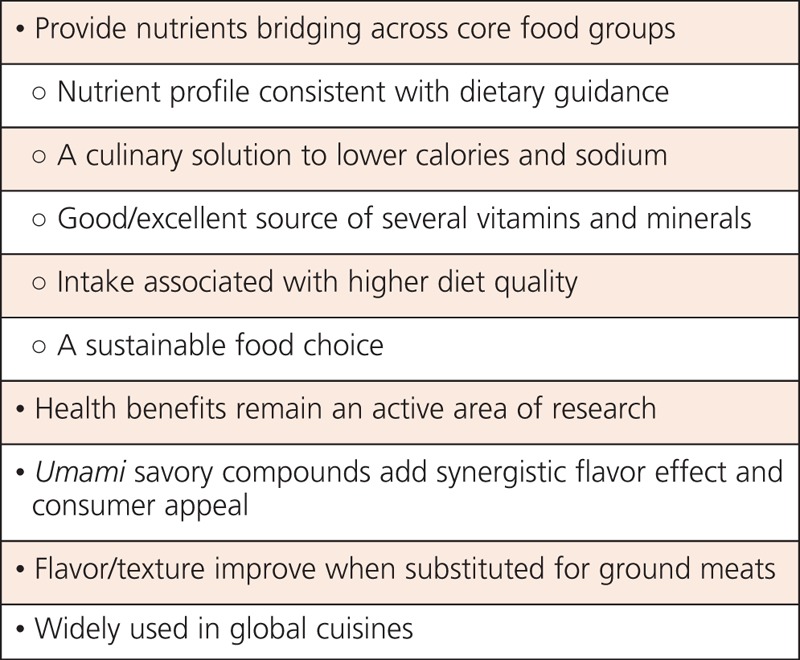
Initially, mycology, the study of fungi, arose as a branch of botany because fungi were considered primitive plants. Fungi now are accepted as a separate kingdom based on cellular organization rather than on observable and other features.1
Major differences that distinguish fungi from both plants and animals include the following:
Plants have chlorophyll and make their own food through photosynthesis.
Animals ingest their food.
Fungi, lacking chlorophyll, exist on decaying material in nature and on substrate of various compositions when commercially grown.
In addition, fungi contain chitin, a polysaccharide derivative of glucose also found in the exoskeleton of crustaceans and insects, not cellulose found in plants, and contain the unique sterol, ergosterol, rather than cholesterol found in mammalian cells.
COMMON EDIBLE MUSHROOMS
Although more than 2000 varieties of mushrooms are edible, those most familiar to US consumers are of the Agaricus bisporus species: the white button mushroom (the most commonly consumed mushroom in the world), crimini, and portabella. Other commercial species are shiitake (Lentinus edodes), straw (Volvariella volvacea), oyster (Pleurotus ostreatus), and enoki (Flammulina ostreatus). Seasonal species such as morels (Morchella esculenta) and chanterelles (Cantharellus cibarius) are gathered in the wild and sold at retail stores and farmers markets. According to the US Department of Agriculture (USDA) National Agricultural Statistics Service, fresh white mushroom per capita consumption is slightly less than 3 pounds per year.
NUTRIENT PROFILE AND CONTRIBUTION TO THE DAILY VALUE
The USDA National Nutrient Database for Standard Reference, Release 27 (SR27), includes composition data on white, crimini, shiitake, enoki, maitake, oyster, portabella, morel and chanterelle mushrooms, and portabella mushrooms exposed to ultraviolet (UV) light that converts the naturally present ergosterol to ergocalciferol (vitamin D2).2 Separate analyses of specific compounds such as the sulfur-containing amino acid ergothioneine and the carbohydrate profile including the fiber-associated monosaccharides, chitin, and β-glucan have been published.3 Ergothioneine cannot be synthesized by humans and has a unique transport system in mammals, suggesting it is important for human health.4 Ergothioneine is found in limited dietary sources: fungi, kidney, liver, black and red beans, oat bran, and a few bacteria. A randomized controlled clinical trial has established ergothioneine’s bioavailability from mushrooms.5 Because there is no Daily Value (DV) for ergothioneine, it is not listed on the Nutrition Facts panel, and no nutrient content claims can be made.
The Nutrition Facts panel lists the nutrient contribution of an 84-g (3 oz fresh) portion of packaged white button mushrooms to DVs established for labeling. Mushrooms provide not only nutrients commonly found in produce, but also nutrients found in meats and grains. Mushrooms are a good (10%–19% DV) source of niacin, pantothenic acid, selenium, and copper and an excellent source (≥20% DV) of riboflavin.6
Mushrooms’ contribution to the DV for some nutrients may be small, yet consistent consumption of mushrooms over time contributes to a nutritious diet. Mushroom consumption is associated with higher intakes of total vegetables, dark green and orange vegetables, and total grains, resulting in higher intake of many nutrients, lower intake of some nutrients to limit, and better diet quality.7 Table 2 lists mushrooms’ contribution to potassium, dietary fiber, vitamin D, and calcium, 4 underconsumed nutrients identified by the 2010 Dietary Guidelines for Americans (DGA) and being considered by the 2015 Dietary Guidelines Advisory Committee at the time of this writing.
Table 2.
Contribution of Food Kingdoms to Under Consumed Nutrients
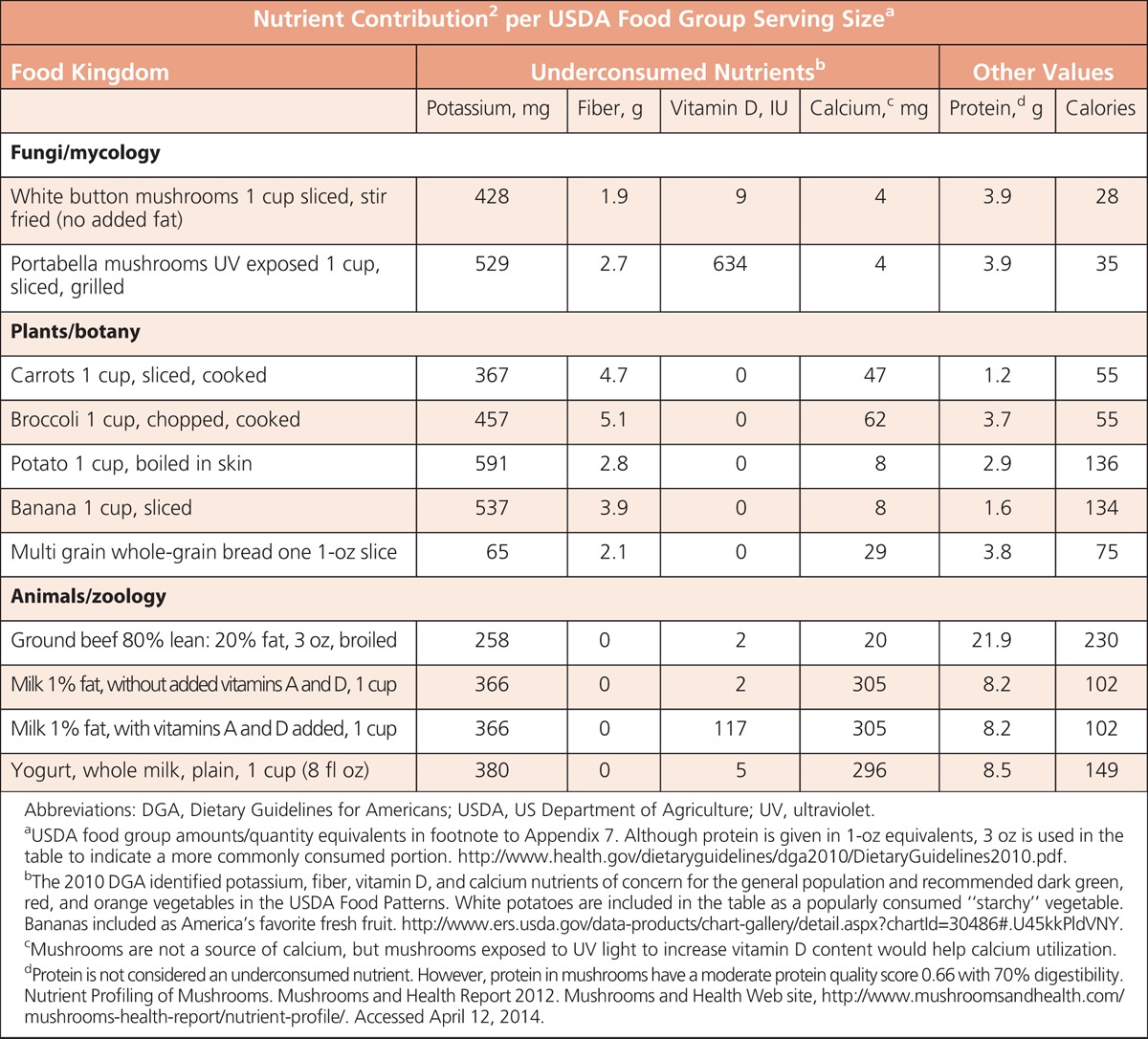
VITAMIN D AND LIGHT EXPOSURE
All mushrooms contain the vitamin D precursor ergosterol, although the vitamin D2 content varies upon exposure to light. Conversion of ergosterol to vitamin D2 ranges from minutes to a few hours for sunlight versus seconds to several minutes when commercially exposed to UV light.8–10 Common, edible varieties in the US retail market (white button, crimini, portabella) grown indoors have levels under 20 IU per 100 g likely related to variable exposure to ambient UV light. See Table 3 for some examples. Mushrooms foraged in the outdoors (morels, chanterelles) have 206 and 212 IU, respectively.2
Table 3.
Growing Condition and Vitamin D Content
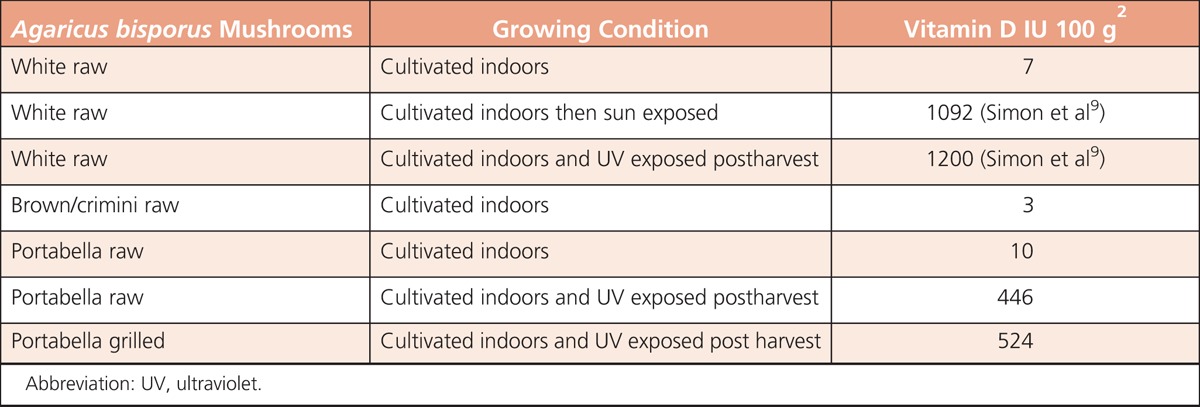
The mushroom industry has used results from controlled studies to identify time and intensity of UV exposure to reach targeted levels of vitamin D, such as 100% of the DV in a Nutrition Facts serving. Consumers also can increase the vitamin D2 in mushrooms purchased at retail by exposing them to sunlight prior to eating. A preliminary trial demonstrated that vitamin D2 in mushrooms can be increased by at least 25% of the Daily Reference Intake (150 IU/70-g serving) by exposure to sunlight for as little as 15 minutes on a clear or partly cloudy day between 9:30 am and 3:30 pm and more than 600 IU in some cases.10
NUTRIENT CONTRIBUTIONS OF THE FOOD KINGDOMS
Mushrooms have been informally categorized among the “white vegetables,” described as the “forgotten source of nutrients.” However, color as a proxy for nutrient contribution may not always account for the multitude of phytonutrients associated with health benefits.11 Although some foods in each of the USDA food groups might be a richer source of a particular nutrient than mushrooms, it is mushrooms’ distributed contribution of a suite of underconsumed nutrients across plant- and animal-based food groups that is unique (Table 2). There is precedent for recognizing unique foods as the DGA states “beans and peas are unique foods,” and their nutrient profile enables them to be counted both as a vegetable and a protein food. Thus, in the current USDA food grouping system, there is opportunity to increase recognition of mushrooms in dietary guidance even in the absence of a formally established “third food kingdom.”
A SUSTAINABLE FOOD CHOICE
Mushroom production is consistent with a sustainable food supply, a dimension of food choices addressed by the 2015 Dietary Guidelines Advisory Committee. Mushrooms, produced in 33 states in the United States, are a local or regional food source, and most mushroom farms are family owned. Mushroom farms recycle byproducts from other agricultural sectors—crushed corn cobs, cottonseed hulls, soybean hulls, peanut hulls, and cocoa shells—providing a useful solution for byproducts that previously posed waste management challenges for other agricultural operations. The substrate material (on which mushrooms are grown) is recycled as a soil amendment. By growing mushrooms indoors, producers are better able to control environmental factors, land use, and related energy and water needs.12 Modern mushroom production is energy efficient, relying on heat generated by composting to help warm production facilities.
MUSHROOMS—A CULINARY SOLUTION WITH NUTRIENT BENEFITS
Data from the NPD (formerly National Purchase Diary) Group’s Nutrient Intake Database 13 show that the average adult consumes just 1.1 cups of vegetables in a typical day, whereas the National Health and Nutrition Examination Survey data14 show average adult vegetable consumption of 1.6 cups per day, less than the 2.5 cups recommended as part of the USDA Food Pattern for a 2000-calorie diet. Integrating more vegetables in entrées or main dishes is one strategy to help consumers meet the recommended goal.
Mushrooms have many flavor and nutrient characteristics that make them an ideal addition to many dishes. Their texture and umami or savory flavor properties make them a suitable substitute for meat. Mushrooms contribute moisture that improves the mouth feel and overall sensory appeal of many dishes, whereas their low energy density (about 92% water) can reduce the energy density of the final dish when taking the place of other higher-energy-dense ingredients.
The use of other umami-rich ingredients, such as tomatoes, that have a synergistic effect with the umami compounds in mushrooms further adds to the flavor and consumer appeal. The interactions of the umami compounds on taste buds create longer-lasting taste sensations compared with the effects of the compound on their own. Traditional global cuisines have combined multiple umami-rich ingredients for millennia to create iconic dishes. For example, in Chinese cuisine, fresh mushrooms that contain naturally occurring glutamate often are combined with dried, rehydrated mushrooms that contain naturally occurring guanylate. Mushrooms and other vegetables rich in umami also have the benefit of being low in sodium and rich in potassium (Table 4).
Table 4.
Umami, Sodium, and Potassium Content of Umami-Rich Foods
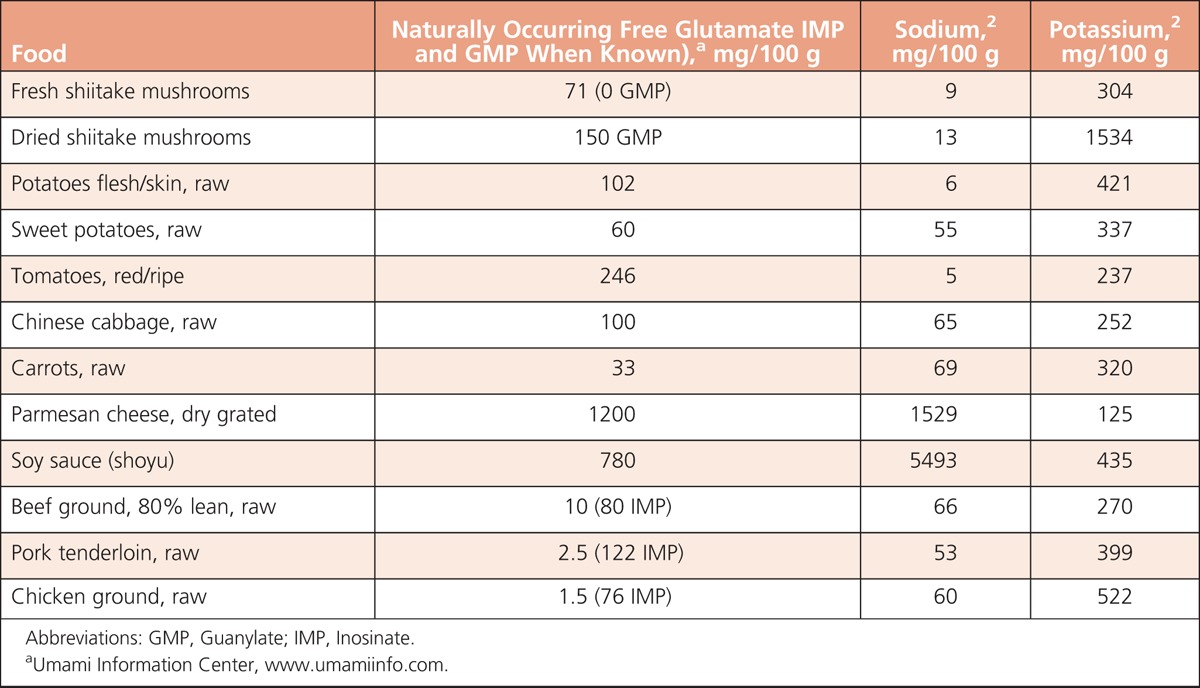
A sensory study15 conducted by The Culinary Institute of America and the University of California, Davis, found that mushrooms, used as a partial substitute for ground beef in popular dishes such as ground beef–based taco fillings, increased consumer appeal by improving the flavor and texture of the finished dish. This research also showed that cooking technique affected the sensory attributes of the mushrooms. Searing and oven roasting are the best cooking techniques to create the meatiest texture and enhance the umami properties. These high-heat techniques (300–500°F) facilitate the Maillard reaction, which enhances the umami properties of the cooked mushrooms up to 7 times their original levels.16 Cooking with mushrooms also can lower food costs. Based on 2014 retail market prices in Northern California at the time of this writing, a 50:50 ground beef with button mushrooms taco blend saves 20% on the food cost, and if 80% of the beef is substituted with mushrooms, the food cost savings increase to 33%.
SCIENCE LINKS MUSHROOMS AND HEALTH
Positioning mushrooms in dietary guidance requires evidence-based research. An initial literature search in 2008 undertaken by Roupas et al17 identified 11 000 articles on mushrooms. This rapidly growing body of evidence on the effects of mushroom intake on a variety of human health outcomes is beyond the scope of this article; however, summaries of these studies are available.17,18 The majority of the human trials to date have focused on immune function and anticancer effects of edible mushrooms and their components, either as a primary or adjuvant therapy.
Stimulation of immune function and some anticancer effects of mushrooms are not mutually exclusive. Polysaccharides from various edible mushrooms have been shown to have antitumor effects in human cell lines, and these polysaccharides generally belong to the β-glucan family (β-d-glucans) and appear to exert their anti-tumor effects, not via a direct cytotoxic effect on cancer cells, but indirectly by stimulation of immune function, allowing a host to better combat the effects of cancer cells. Reviews have been published on the immunomodulatory activities of mushroom polysaccharides,19 on the health effects of β-glucans in mushrooms,20 and on the immunobiology of mushrooms.21
Promising studies include those indicating an inverse relationship between mushroom consumption and breast cancer risk, with consistent results along a continuum of investigations, from in vitro studies using human cell lines in culture and animal studies, through to recent human trials. The in vitro and animal trials to date have reported an inhibition of aromatase activity and subsequent reduction of estrogen by mushroom extracts, which provide a physiologically relevant mechanism for effects on estrogen receptor–positive tumors. Evidence has also suggested that the antiaromatase compound in A bisporus is conjugated linoleic acid.22,23 The presence of conjugated linoleic acid, also found in meat and dairy products, is another example of how mushrooms—biologically neither a plant nor animal—provide nutrients found in either or both.
CLINICAL TRIALS AND RESEARCH IN PROGRESS
Table 5 is a selection of the approximately 40 clinical trials on common edible mushrooms on international clinical trial registries at the time of this writing. These trials will add to the current evidence on mushroom intake and health outcomes such as obesity via use of mushrooms in weight loss and weight maintenance diets, the use of mushroom intake to address vitamin D deficiency, and potentially on vitamin D–related health outcomes such as immunity, bone metabolism, muscle function, cognition and mood outcomes, metabolic syndrome, and prediabetes. A human trial has shown that vitamin D2 from vitamin D2–enriched brown button mushrooms (A bisporus) (enriched via UV exposure) is bioavailable and effective in improving vitamin D status, with the effect not different to a vitamin D2 supplement.24 Trials on vitamin D2–containing mushrooms on participant D status are in progress and, if successful, will add to the body of evidence for the effects of dietary mushroom intake on vitamin D–mediated human health outcomes.
Table 5.
Some Currently Registered Clinical Trials on Mushrooms and Human Health Outcomes
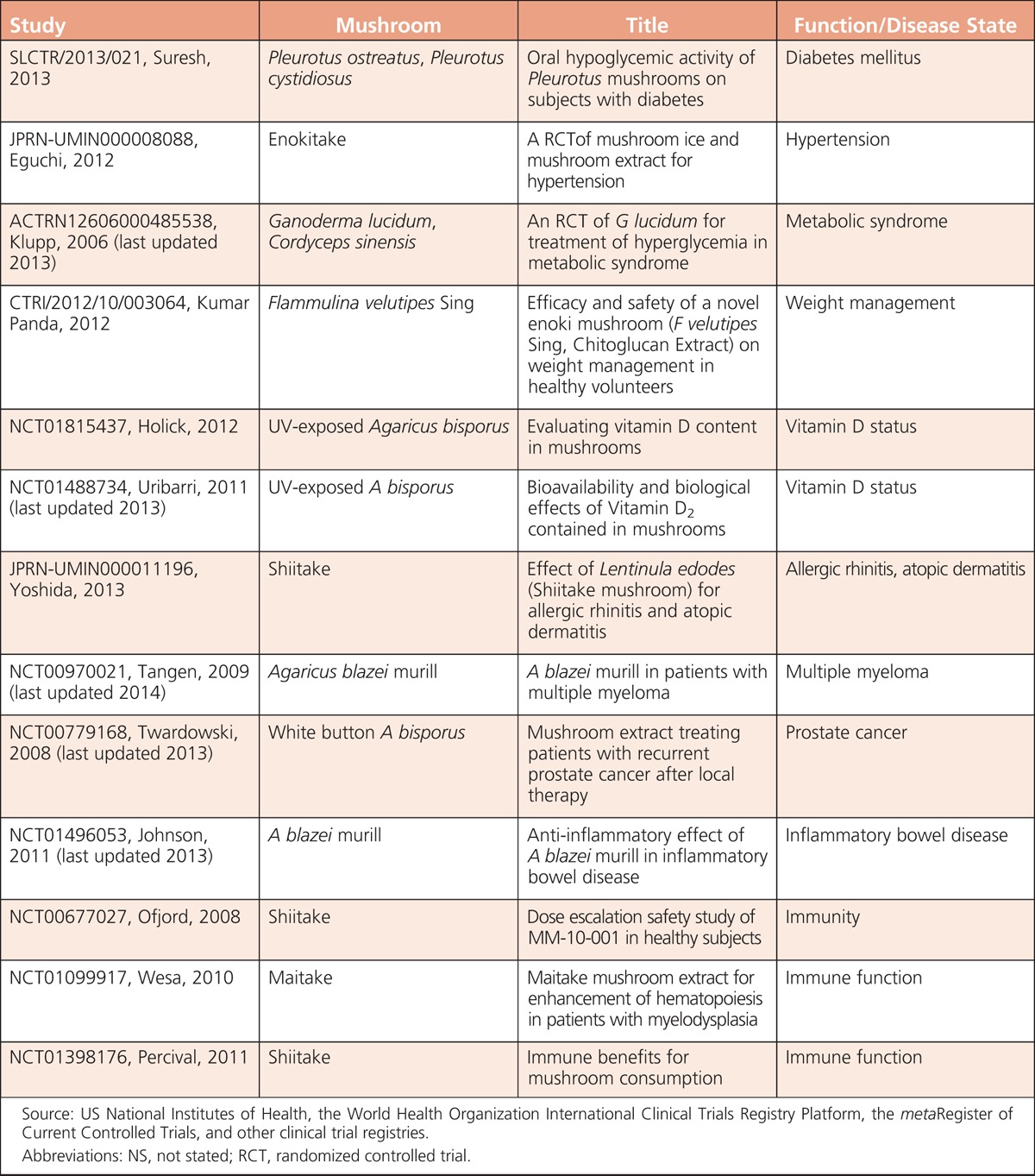
Preliminary trials in subjects with type 2 diabetes have reported a hypoglycemic effect of mushrooms and mushroom components. There is a high level of consistency between the effects of mushroom extracts in preliminary data from human trials and results in diabetic animal models that have mirrored decreases in plasma glucose, blood pressure, cholesterol, and triglyceride concentrations, thereby strengthening the level of evidence for antidiabetogenic effects of the studied mushrooms and their extracts.
Newly registered trials are also evaluating the efficacy of mushroom intake on human health outcomes not previously studied, for example, the efficacy of mushroom intake on sports performance (oxygen kinetics, aerobic power, and time to fatigue).
GOING FORWARD: THE FUTURE FOR FUNGI
Animal and in vitro experiments have provided some insights into the cellular mechanisms linking mushrooms and health. Ultimately, additional well-designed clinical trials are needed to further substantiate human health outcomes from mushrooms and mushroom components that support their greater recognition in nutrition guidance. As stated previously, there is an opportunity to increase recognition of mushrooms in the USDA food groups while discussion continues on establishing a “third food kingdom.”
In the short term, mushrooms can continue to ride the wave of positive dietary guidance relative to plant-based diets and vegetable intake while research builds on their unique composition and use as a whole food to help consumers improve their health. In the longer term, based on their utility to improve diet quality, enhance flavor without additional sodium, and provide ways for consumers to consume smaller portions of animal protein, mushrooms may deserve a more prominent place in dietary guidance recommendations that recognizes their uniqueness.
PRACTICE IMPLICATIONS
Investigators/researchers: keep current on the science linking mushrooms and health; become familiar with the different food kingdoms: fungi, plants, and animals; refer to the USDA Nutrient Database for Standard Reference for mushrooms’ nutrient profile.
Nutrition practitioners: use the Nutrition Facts panel to inform consumers of mushrooms’ nutrient benefits; explain to consumers who still use mushrooms as a “garnish” that these benefits are based on a 3-oz fresh serving.
Culinary nutrition professionals: recognize that cooking technique affects the umami properties of mushrooms; roasted and seared mushrooms have more umami than raw, steamed or sautéed mushrooms because of the effects of the Maillard or browning reaction.
Consumers: use mushrooms with foods from all food groups to improve diet quality; blend mushrooms with animal protein to lower the energy density of meals—and food costs.
Supplementary Material
Acknowledgment
The authors thank Debra Krause (CSIRO, Australia) for compiling the information on current clinical trials.
Footnotes
Ms Feeney coordinates the Nutrition Research Program of the Mushroom Council; CSIRO has received research funding from the Australian Mushroom Growers’ Association; the Culinary Institute of America has received research grant funding, and Ms Miller has received honoraria from the Mushroom Council. The Mushroom Council (San Jose, California) provided funding to support writing the article.
The authors have no conflicts of interest to disclose.
References
- 1. Carlile MJ, Watkinson SJ. The fungi as a major group of organisms. In: The Fungi. London, UK: Academic Press; 1980: 3– 6. [Google Scholar]
- 2. USDA National Nutrient Database for Standard Reference. http://ndb.nal.usda.gov/. Accessed August 5, 2014.
- 3. Dikeman CL, Bauer LL, Flickinger EA, Fahey GC., Jr Effects of stage of maturity and cooking on the chemical composition of select mushroom varieties. J Agric Food Chem. 2005; 53: 1130– 1138. [DOI] [PubMed] [Google Scholar]
- 4. Gründemann D, Harlfinger S, Golz S. Discovery of the ergothioneine transporter. Proc Natl Acad Sci U S A. 2005; 102: 5256– 261. [DOI] [PMC free article] [PubMed] [Google Scholar]
- 5. Weigand-Heller AJ, Kris-Etherton PM, Beelman RB. The bioavailability of ergothioneine from mushrooms (Agaricus bisporus) and the acute effects on antioxidant capacity and biomarkers of inflammation. Prev Med. 2012; 54: S75– S78. [DOI] [PubMed] [Google Scholar]
- 6. Nutrition Benefits. Nutrition Facts Panel. www.mushroominfo.com. Accessed June 5, 2014.
- 7. O’Neil CE, Nicklas TA, Fulgoni VL., III Mushroom intake is associated with better nutrient intake and diet quality: 2001–2010 National Health and Nutrition Examination Survey. J Nutr Food Sci. 2013; 3: 5. [Google Scholar]
- 8. Kalaras MD, Beelman RB, Elias RJ. Effects of postharvest pulsed UV light treatment of white button mushrooms (Agaricus bisporus) on vitamin D2 content and quality attributes. J. Agric Fool Chem. 2012; 60: 220– 225. [DOI] [PubMed] [Google Scholar]
- 9. Simon RR, Phillips KM, Horst RL, Munro IC. Vitamin D mushrooms: comparison of the composition of button mushrooms (Agaricus bisporus) treated postharvest with UVB light or sunlight. J Agric Food Chem. 2011; 59: 8724– 8732. [DOI] [PubMed] [Google Scholar]
- 10. Phillips KM, Rasor AS. A nutritionally meaningful increase in vitamin D in retail mushrooms is attainable by exposure to sunlight prior to consumption. J Nutr Food Sci. 2013; 3: 236. [Google Scholar]
- 11. Weaver C, Marrs ET. White vegetables: a forgotten source of nutrients: Purdue roundtable executive summary. Adv Nutr. 2013; 4: 318S– 326S. [DOI] [PMC free article] [PubMed] [Google Scholar]
- 12. Lonie J, Phelps L. Sustainable production practices in mushroom farming. Mushroom News. 2011; 59: 4– 8. [Google Scholar]
- 13. State of the Plate: 2010 Study on America’s Consumption of Fruits and Vegetables. Produce for Better Health Foundation. http://www.pbhfoundation.org/pdfs/about/res/pbh_res/stateplate.pdf. Accessed June 4, 2014.
- 14.US Department of Agriculture, Agricultural Research Service and US Department of Health and Human Services, Centers for Disease Control and Prevention. What We Eat in America, Health and Nutrition Examination Survey (NHANES) 2001–2004. Dietary Guidelines for Americans. 2010. Chapter 5. www.dietaryguidelines.gov. Accessed June 4, 2014. [Google Scholar]
- 15. Myrdal Miller A, Mills K, Wong T. Flavor-enhancing properties of mushrooms in meat-based dishes in which sodium has been reduced and meat has been partially substituted with mushrooms [published online ahead of print August 14, 2014]. J Food Sci. 2014. [DOI] [PubMed] [Google Scholar]
- 16. Festring D, Hofmann T. Systematic studies on the chemical structure and umami enhancing activity of Maillard-modified guanosine 5′-monophosphates. J Agric Food Chem. 2011; 59( 2): 665– 676. [DOI] [PubMed] [Google Scholar]
- 17. Roupas P, Keogh J, Noakes M, Margetts C, Taylor P. The role of edible mushrooms in health: evaluation of the evidence. J Funct Foods. 2012; 4( 4): 687– 709. [Google Scholar]
- 18. Feeney MJ, Dwyer J, Hasler-Lewis C. Mushrooms and health summit proceedings [published online ahead of print May 8, 2014]. J Nutr. 2014. [DOI] [PMC free article] [PubMed] [Google Scholar]
- 19. Cheung PCK, Wong KH, Lai CKM. Immunomodulatory activities of mushroom sclerotial polysaccharides. Food Hydrocoll. 2011; 25( 2): 150– 158. [Google Scholar]
- 20. Rop O, Mlcek J, Jurikova T. Beta-glucans in higher fungi and their health effects. Nutr Revs. 2009; 67( 11): 624– 631. [DOI] [PubMed] [Google Scholar]
- 21. Borchers AT, Krishnamurthy A, Keen CL, Meyers FJ, Gershwin ME. The immunobiology of mushrooms. Exp Biol Med (Maywood). 2008; 233( 3): 259– 276. [DOI] [PubMed] [Google Scholar]
- 22. Kanaya N, Kubo M, Liu Z, Chu P, Wang C, Chen Y-CYS. Protective effects of white button mushroom (Agaricus bisporus) against hepatic steatosis in ovariectomized mice as a model of postmenopausal women. PLoS One. 2011; 6( 10): e26654. [DOI] [PMC free article] [PubMed] [Google Scholar]
- 23. Chen S, Oh SR, Phung S. Anti-aromatase activity of phytochemicals in white button mushrooms (Agaricus bisporus). Cancer Res. 2006; 66( 24): 12026– 12034. [DOI] [PubMed] [Google Scholar]
- 24. Urbain P, Singler F, Ihorst G, Biesalski HK, Bertz H. Bioavailability of vitamin D(2) from UV-B–irradiated button mushrooms in healthy adults deficient in serum 25-hydroxyvitamin D: a randomized controlled trial. Eur J Clin Nutr. 2011; 65( 8): 965– 971. [DOI] [PubMed] [Google Scholar]
Associated Data
This section collects any data citations, data availability statements, or supplementary materials included in this article.


